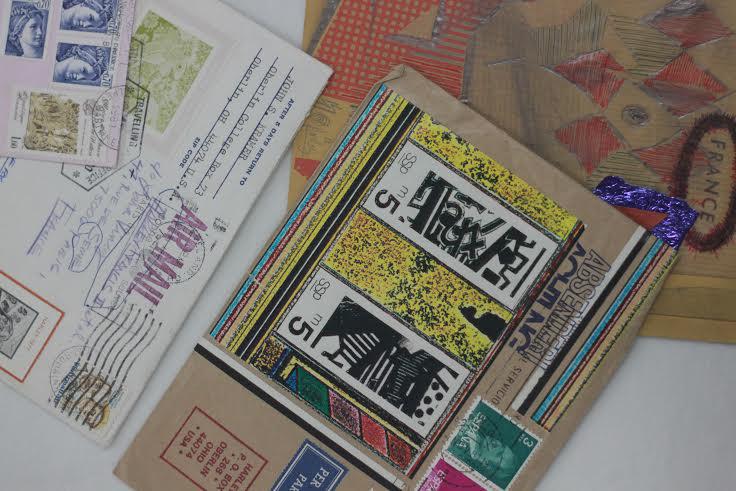Art Library Displays Selections from Vast Mail Art Collection
The Clarence Ward Art Library houses a display from the much larger collection of mail art archived at Oberlin. The full compilation was cataloged this summer and is available for public perusal.
October 3, 2014
At the center of the Clarence Ward Art Library, there is a small display case that houses 10 highly detailed postcards embellished with text and imagery — an eclectic sample of Oberlin’s vast collection of mail art. Each piece is extremely personalized, some scattered with stamps, some with script, some with ink and paint, and most containing a combination of the three.
The mail art movement dates back to the late 1950s and was conceived out of Marcel Duchamp’s ideas of art as a challenge to pre20th century artistic conventions. Mail art provides a means of making art accessible by using everyday objects such as postcards, paper, recyclable materials and stamps. Because mail art is only considered to be art once it is dispatched from a sender, the circulation of mail art relies on interpersonal communication between artists to exchange ideas. Thus, participating artists are able to form an interconnected network to circumvent traditional distribution of art. College senior Jay Rosen, the first person to view many of the pieces he archived during the summer, said that a lot of the pieces of mail art he first encountered appeared to be untouched. Initially, when his job as a summer archivist started, there weren’t any plans to put together a mail art case. However, he kept tabs on all of the art he stumbled upon and liked. Eventually, a few pieces he selected received enough attention to be placed on display. “It’s probably the most accessible and democratic global art movement, yet no one really knows about it,” Rosen said. “There are no galleries, there is no hierarchy of submitting your work and getting rejected, and you don’t have to pay, besides postage. It’s just so open and available to anyone.”
Oberlin College’s extensive collection includes over 25,000 works of mail art by approximately 1,800 artists from around the world. During the summers of the 1960s, Oberlin’s Art Librarian Ellen Johnson would travel to New York City to learn about new art movements, become friends with famous artists and acquire pieces for the College at affordable rates. She was the first person to bring mail art to Oberlin, eventually acquiring the collections of Harley Francis and Reid Wood, two local mail artists. In the spring of 2012, the Exhibition Initiative presented the first large-scale display of selected pieces from the mail art collection and included a comprehensive historical narrative to explain the works. All of the school’s correspondence art has been cataloged so that it is physically protected yet students may still access it.
As Art Library Director Barbara Prior paged through one of the hundreds of folders of mail art that the library has spent the past decade cataloging, she said the tactile nature of the art is what draws viewers looking to experience it. “[Mail art is] a personal communication that you are invited to pick up and hold and experience. Mail art bridges that gap because it chooses a medium that is familiar and intimate and that people are immediately drawn to,” Prior said.
Although familiarity is an aspect of this art form’s approachability, it is easy to feel like a voyeur while looking at the collection. “The problem with a mail art piece or a corpus of mail art is that since it’s all personal communication, the meanings and interpretations of the piece are very contextual and sometimes very personal as well,” Prior said. There are so many messages that are conveyed through mail art, but all conclusions drawn about the meaning can remain uncertain.
The display case contains a small portion of Oberlin’s mail art, but there are many other ways to explore the collection. Scans of the full collection can be accessed online under the Special Collections section of the Art Library’s main page. The works are also available in hard copy by appointment. This year, there will be a Winter Term course offered that focuses on mail art. In the spring, there will be a larger exhibit of mail art in Mudd library, as well as a lecture by Vanessa K. Davidson, curator of Latin American Art at the Phoenix Art Museum, that will focus on decoding political and cultural histories through mail art.



















